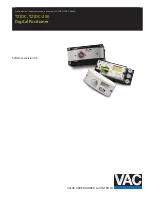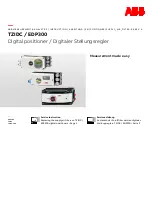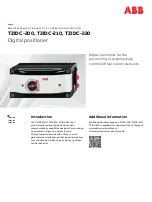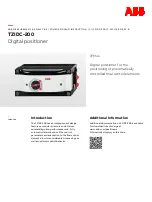
20
Model EA91A&EA90A
Cam
Lock Screw
Stroke
Adjustment Needle
Stroke Adjustment Knob
Hexagon Nut
with Flange
6.2 Adjusting Procedure
⑴ Set input signal to 50%. Then, adjust to 50%
point of specified stroke with zero adjustment
knob.
⑵ Move the input signal between 25% and 75%,
and make sure that the stroke is set to 25%
and 75% of specified stroke. If the stroke is
not within tolerance, adjust input signal to
specified stroke by repeating stroke adjust-
ment and zero adjustment while checking plus
or minus of the specified stroke. If specified
stroke point is obtained with the adjustments,
the input signal between 0% and 100% will
approximately adjust reference stroke point.
⑶ If shut-off power of valve is considered as
important, check as follows. For DA (Direct
Action), make sure that the input signal is
greater than the reference value and the nee-
dle of pressure gauge in OUT side indicates
approx. supply pressure. For RA (Reverse
Action), make sure that the input signal is
less than the reference value and needle of
pressure gauge in OUT side indicates approx.
zero.
※For cam type, basically perform same proce-
dures since the specified stroke is the speci-
fied angle. However, perform cam position
adjustment described in Items 6.1 and 6.4.
6.5 Stroke Adjustment
(Common to Linear Type and
Built-in Cam Type)
⑴ Loosen lock screw fixing stroke adjustment
knob of the stroke adjustment lever.
⑵ If making the stroke (angle) wider, adjust
by turning screw of stroke adjustment lever
clockwise.
⑶ If making the stroke (angle) narrower, adjust
by turning screw of stroke adjustment lever
counterclockwise.
⑷ Performing these adjustments while watch-
ing the indication on the stroke
adjustment lever.
⑸ After setting is completed, be sure to tighten
the lock screw securely.
6.6 Split Range Adjustment
(Common to Linear Type and
Built-in Cam Type)
⑴ The split range has four types such as 1/1.5,
1/2, 1/3, and 1/4 for both linear and built-in cam
types.
⑵ For replacement parts of split range, use
feedback spring and zero adjustment spring.
The identification table is shown below.
⑶ Move the stroke adjustment knob of stroke
adjustment lever to meet required stroke.
Then, adjust the stroke in accordance with
procedures from Items 6.2 to 6.5 while inputt
-ing the input signal as specified in the speci-
fication.
6.3 Zero Adjustment (Common to
Linear Type and Built-in Cam
Type)
⑴ The output increases (start point rises) by
turning the zero adjustment knob clockwise
(downward).
⑵ The output decreases by turning the zero
adjustment knob counterclockwise (upward).
6.4 Zero Adjustment for Cam
The zero origin position of proper part of cam is
inscribed on cam surface. Check the opening of
valve, loosen hexagon nut with flange, and adjust
the position.
−
+































